Greg Maas currently serves as the Technical Director for the Utah Youth Soccer Association (UYSA), where he is responsible for player development, coaching education, and the technical direction of the State association. Maas holds a USSF A License, USSF National Youth License and his NSCAA International Premier Diploma. Maas also serves as a National Staff Coach and Instructor with US Soccer and as a Goalkeeping Academy Staff Coach with the NSCAA. Greg currently serves as an Advisory Panel member at SoccerSpecific and is a regular contributor.
Scoring Patterns of Play
Activity #1 Unrestricted:
Set Up:
Divide team into groups of 3 as shown below in Diagram (a). Each group begins with one ball, passing and moving collectively.
Note: For illustration purposes only one group of 3 is diagrammed.
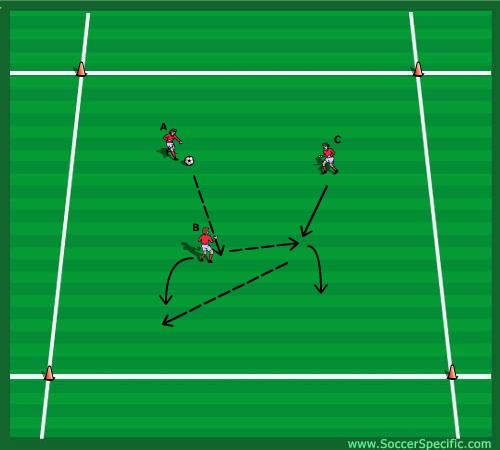
Explanation:
The following patterns are emphasised;
Pattern 1 (see Diagram (a) above). (A) passes to (B); who plays ball into space for (C); (B) spins away from (C); who then plays a through ball back to (B). (C) continues forward and joins (B) in the attack. Play is continuous.
Pattern 2 (see Diagram (b) below). (A) passes to (B); who plays ball back to (C); (B) follows pass and runs forward; (A) then runs forward and receives a through ball from (C) into the space (B) created. (B) then joins the attack. Play is continuous.
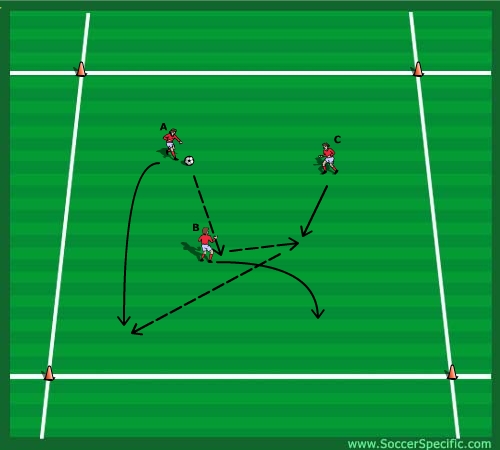
Coaching Points:
- Body mechanics, shape, and general technique.
- Correct supporting angles, timing, and deceptive runs.
- Accuracy, weight, timing, and quality of [penetrating] pass.
- Verbal and visual communication.
Activity #2 Restricted Space:
Set Up:
Two large goals with goalkeepers (30 x 40 area). Players form two groups and stand at opposite corners. One player begins as the target player in the middle for each group as shown in Diagram (c) below.
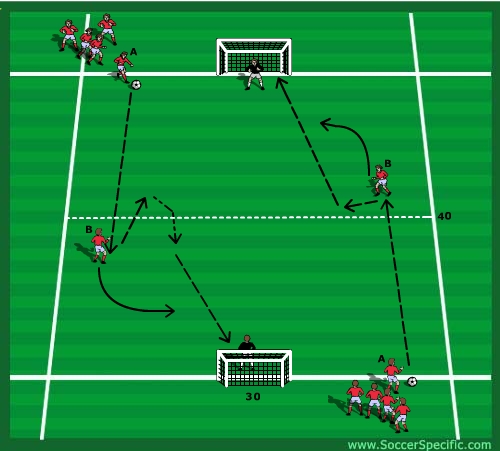
Explanation:
The first player in line (A) passes to target player (B) as shown above. Both sides of the pitch work at the same time. The target player must lay-the-ball off to (A) for a shot on goal. Target player rotates to opposite line; shooter rotates to become next target player. If the shooter receives the ball in the attacking ½ of the field, they must shoot the ball first-time. If the shooter receives the ball in the back ½ of the field, they can dribble to prepare the ball to strike. Be sure that the target player [spins] away from the ball and follows the strike on goal and finishes any rebound or 2nd chance opportunities. Switch starting positions to [other] side of the field which creates ball striking with the opposite foot. Play is continuous.
Coaching Points:
- Proper timing of pass and combining runs to goal
- Proper selection of striking surface
- Placement versus power – hit the target!
- Positive attitude and confidence to score
- Finish all 2nd chance opportunities
Activity #3:
Set Up:
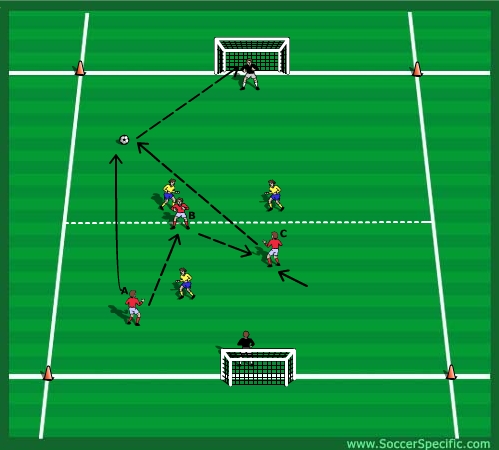
3 v 3 with goalkeepers to two large goals as shown below in Diagram (d) (30 x 40 area or as needed).
Explanation:
Objective is to combine and score by implementing trained patterns of play. In Diagram (d) above, Player (A) has passed to (B). (B) has layed the ball back for (C). (A) has continued his/her run to receive a through-ball from (C). Add a neutral player if necessary to create more success. Be aware – too many players decreases available space and may limit a player’s movement off of the ball. Implement the Offside Rule to keep it realistic. Rotate after time or once an established number of goals are reached.
Coaching Points:
- Correct attacking shape and balance.
- Awareness of passing gaps in the defensive line.
- Angled passes and timing of runs.
- Speed of play and decision making.
- Finishing technique and confidence.
Final Activity:
Set Up:
7 v 7 with goalkeepers to two large goals as shown below in Diagram (e). (50 x 70 or as needed).
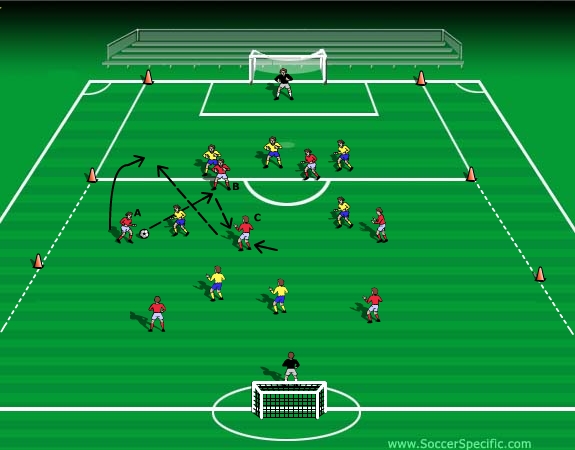
Explanation:
Both teams compete for possession of the ball and attempt to score in their opponents goal. Emphasis is placed on utilizing trained patterns. In the Diagram above, Player (A) has again combined with a forward and continued his/her run forward. Player (C) has moved into position to receive the lay-off from (B). Player (C) slots the ball inside the defender for (A).
Possible formation 1:2:3:2 vs. 1:3:2:2
Coaching Points:
- Find the most efficientand effective way possible to score.
- Find a way to win.
- Reward decisive actions.
- All of the above mentioned points.
Cool Down:
- Dynamic movements and static stretching.
- Focus on major muscle groups.
- Reduce heart rate.
- Review Session.
